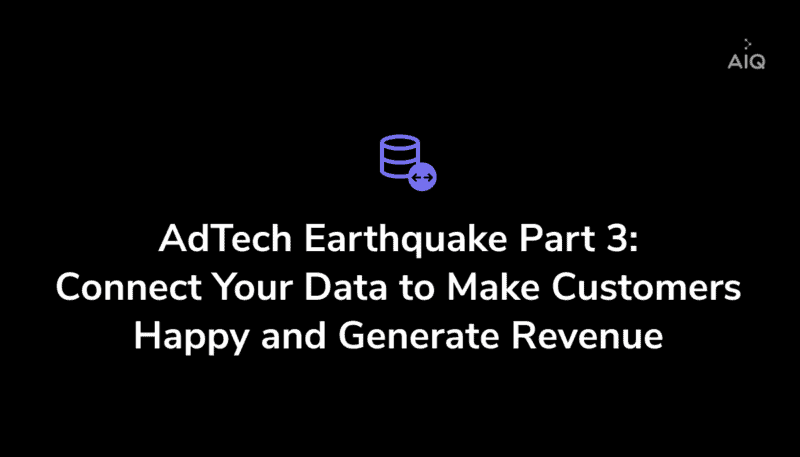Connect Your Data to Make Customers Happy and Generate Revenue

In this three-part series, we first examined the rise of the privacy-first economy and the disappearance of third-party customer data, which for years has been the main fuel of digital advertising. In part two we took an inventory of the data still available to brands (principally, first-party data) and the ways brands can use it to guide advertising and marketing in a post-IDFA world.
Now, it’s time to consider the technologies and processes you need to maximize the value of that data, make your current customers happy and generate revenue. Remember, data collection may be a cost center, but data in action is a revenue generator. Make that happen and you can turn this time of uncertainty into a unique opportunity to shine.
But first, you need to overcome challenges that may seem daunting. For example, your first-party customer data is probably generated within a range of systems, not all of which talk to one another. So you must find ways, through data unification and identity resolution, to gain a holistic picture of your customer base. Just as important is empowering marketers to gather insights and turn them into creative action without constantly relying on IT. Finally, remember that this is a brand new world we are entering with a whole new set of rules. To succeed, you have to be willing to experiment, learn what works and what doesn’t, and respond with agility to changing conditions.
These are serious challenges to the status quo, requiring everything from new technologies to new operating models. To create a path to success, we have broken down the process of transformation into five critical steps:
- Retake control of customer data and relationships
- Rationalize your martech stack
- Put identity at the core of your first-party strategy
- Select relevant technology and capabilities
- Experiment, measure and iterate
1. Retake Control of Customer Data and Relationships
Overwhelmed by the complexities of gathering and activating customer data, many brands have essentially chosen to outsource their customer relationships. They’ve turned to outside agencies for everything from the execution of paid media campaigns to CRM software services and operations.
But in the digital economy, the customer experience (CX) is the front line in the battle to win and retain new customers. In other words, CX needs to be a core competency of every brand, so it’s time to bring the core functions of customer experience in house.
Fortunately, there’s a new generation of technology that can both unify data to uncover insights and empower businesses to transform those insights into orchestrated omnichannel experiences. An omnichannel customer journey can heighten customer satisfaction and customer retention, which leads to increased revenue and brand loyalty.
There are three steps to take back control of your customer data:
- Set the vision for CX: You need a North Star to guide your organization, which comes down to one principle — how you want customers to perceive your brand. With this vision in place, you can more effectively develop short-term and mid-term goals.
- Build the right team: To become customer-centric, brands need to build teams that combine both business and analytical skills and can make data-driven decisions using the right technologies.
- Invest in operations: Brilliant customer insights only generate real value when you can execute on them at scale. This requires a strong marketing operations team, plus the tools and technologies that can scale and coordinate activities across millions of customers and dozens of touchpoints.
2. Rationalize Your Stack
Amid the digital advertising earthquake, you need to revisit every component in your CX stack. Your goal: Reduce costs while increasing operational agility. Remember, you can’t change everything in a day. On the other hand, you shouldn’t let the constantly changing environment keep you from acting. Instead, resolve to make the best possible decision at the time you make it.
Of course, everyone’s martech infrastructure is different. However, there are some clear steps everyone can take, regardless of the unique nature of their stack:
- Leverage existing investments: Look for opportunities to add value to existing investments as much as possible. Rarely are rip-and-replace missions either necessary or successful.
- Focus on integrations: Ensure you’re building an integrated stack with flexibility to swap elements in and out as strategies, needs and budgets change.
- Think cost control: Reduce capability duplication across your stack and consider swapping out components that are costly to maintain relative to the value they deliver.
- Lean on data partners: For brands with limited access to first-party data, a strong data partnership ecosystem will be critical in the transition to a privacy-first economy.
- Plan for change management: When you work with new data sources in new ways and bring critical processes in house, you also need to make organizational changes. Take a proactive approach to change management.
- Democratize your data: Democratizing data across business and analytics teams enables them to approach new use cases with agility. In this way, they can respond to constant change with an iterative, test-and-learn approach.
- Data governance and privacy by design: Regulations on customer data collection and usage are constantly evolving. To remain compliant, select systems engineered to keep you and your data safe.
3. Put Identity at the Core of Your First-Party Strategy
Your first-party data will likely come from siloed systems. As a result, you risk making decisions on partial knowledge and delivering disconnected customer experiences. For a holistic view of each existing customer and the customer relationship, you need a way to gather all relevant data and associate it with a single customer.
An identity graph is a powerful tool to gather and link all the identifiers associated with an individual. Identifiers can be either anonymous (e.g., associated with a device or browser) or known (e.g., associated with a unique identifier like an email or phone number). Identity graphs help connect both known and anonymous identifiers with a single person.
With the right customer data platform (CDP), you can quickly and efficiently build and maintain a “private” identity graph that relies on the customer data you yourself have collected. The solution must be able to match and merge identities, and then stitch all the data gathered across these identities to give you a true, 360-degree view of current customers.
For a private identity graph to be effective, it must accurately gather data from any upstream data source and then be able to share that data with any downstream CX system. However, not all identity graphs are built equally. Too often brands consider the match rate the most important measure of a graph. However, quantity and quality are not synonymous. In addition, global brands may need to consider a local identity graph provider since not every vendor is able to provide a strong graph for every market.
4. Select Relevant Technology and Capabilities
A modern marketing department requires a wide range of martech solutions. But let’s hone in on three technologies directly involved with unifying customer data from disparate sources and making it actionable. Note that two of the technologies — CDPs and clean rooms — are new, so it’s important to evaluate choices carefully and select solutions that best meet the unique needs of your business.
DMPs
Chances are you — or your agency — have been using a data management platform (DMP) to execute use cases such as prospecting and retargeting on paid media channels. The ROI on DMP investments has long been dubious. More problematic, these expensive solutions are primarily built around cookies and third-party data. As access to third-party cookies disappears in the privacy-first economy, their value becomes even more questionable. Even Adobe, a major DMP vendor, predicts their demise. Learn more about the differences between CDP vs. DMP here.
CDPs
According to a recent Epsilon study, the deployment of a CDP is the primary action marketing organizations are taking to address the adtech earthquake. In the privacy-first economy, CDPs remain highly relevant since they’re engineered for first-party customer data. In fact, a CDP can ingest all relevant data, whether first-, second- or third-party. They also include identity stitching capabilities that provide the all-important 360-degree view of your customer base.
Clean Rooms
Clean room solutions are designed to allow brands to benefit from the data collected by a publisher (e.g., Google) or other walled garden while still protecting the privacy of users. In a post-cookie world, they offer an alternative path for measurement and attribution of ad campaigns — ensuring compliance with privacy regulations by sharing only pseudonymized data within the clean room itself. Many expect all publishers, eager to attract ad revenue, to offer some version of a clean room solution.
5. Experiment, Measure and Iterate
The privacy-first economy is a new Wild West for every marketer — a risky terrain, but one that can deliver generous rewards to those that navigate it successfully. But as with any journey into unknown territory, you need to observe conditions carefully and remain ready to adjust your marketing strategy quickly.
In other words, don’t expect to invest in new technology, hit the “on” switch and see immediate blockbuster results. Instead, begin by identifying your biggest challenges and map them to a set of key use cases and requirements. Then investigate the latest options that technology vendors, publishers and agencies are offering and evaluate how well they address your needs.
Once you have your teams and systems in place, be willing to experiment. However, you should also make sure you can also measure the results of those experiments. Just as important is building agile teams and empowering them with technologies that allow them to learn and iterate quickly.
Avoid overwhelming your team and stay focused by organizing your initial efforts around three key areas:
Identity
The identity space is about to get a lot more complex, so choose your identity partners carefully. Unified Identity 2.0 — started by The Trade Desk and recently joined by Prebid.org — is drawing a lot of buzz. However, it’s unlikely that we’ll see global adoption of a single solution. Other vendors include Neustar Fabrick ID, LiveRamp Identity Link and LiveRamp Authenticated Traffic Solution. Likewise, brand offerings such as Verizon Media ConnectID and Walmart Connect have the potential to become powerful partners depending on the needs of your business.
Targeting
Targeting, an essential part of a marketing strategy, impacts customer experience, creates brand loyalty and attracts potential customer groups. To enable effective targeting while respecting consumers’ privacy, Google’s Federated Learning of Cohorts (FLoC) program is exploring solutions based on groups of users with shared attributes. Google has already announced promising results from their tests, though questions remain.
Attribution and Measurement
The disappearance of cookies, as well as changes to Apple’s IDFA policy, is seriously hindering marketing attribution and measurement. As a result, traditional solutions will no longer be viable. In response, identity solutions vendor and ActionIQ partner Neustar is proposing a unified marketing measurement model that leverages both traditional marketing mix models (MMM) and multi-touch attribution (MTA). Mobile measurement partners (MMPs) such as Branch, Appsflyers, Kochava and Adjust are exploring privacy-friendly measurement and attribution strategies. Brands must be willing to experiment and discover which of these technologies best moves their marketing strategies forward and helps to meet their unique goals, whether that’s revenue growth, increasing online sales or heightening customer loyalty.
Now it’s Your Turn — Game On!
The changes to adtech have already begun — and they’re profound. The time to act is now. We hope we’ve provided you with increased clarity and some effective strategies as you move forward. If you have any questions or want to discuss strategies that could benefit your brand, contact ActionIQ to speak with one of our experts.





